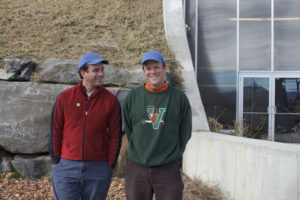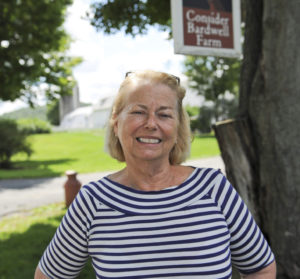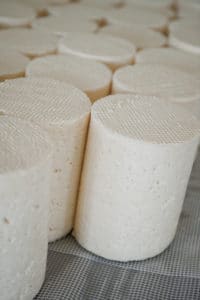What Makes Vermont’s Award-Winning Cheese Engine Run?

Andy and Mateo Kehler are the owners of Jasper Hill Farm in Greensboro, VT. Photo courtsy of Jasper Hill Farm
Vermont holds the brass ring as the premier state hosting the most artisan and farmstead cheese makers per capita in the country. Not bad for a little place with a lot of rocky hillside farms and barely 650,000 people. As the cheesemakers expand and improve, the prizes keep coming, the sales keep mounting and the cash registers keep ringing.
According to the Vermont Cheese Council, twelve of its 45 members (who produce over a 150 different cheeses) took home thirty ribbons in August of this year from the prestigious (known as the “big deal”) American Cheese Society show in Raleigh/Durham North Carolina. In June, Vermont Butter and Cheese Creamery, a big winner at ACS was “elated to report” that it took sofi Gold medal awards for all three categories at the National Association for the Specialty Food Trade annual competition in Washington, D. C. The celebrated creamery also took two golds, a silver and a bronze at the 2012 World Championship Cheese Contest.
So Vermont has been in the vanguard of a new revolution in the craft of American cheese-making which began about twenty five years ago with the first wave of ‘back-to-the-landers’ and ushered in the era of serious competition with European cheese-makers. The question is why? Why Vermont? Why now?
Nothing happens in a vacuum, especially in a small state like Vermont where people point to important players in the growth and success of the artisan and farmstead cheese industry. Artisan cheese refers to cheese that is handmade from milk purchased from nearby farms, while farmstead cheese is made on the farm where animals are raised.
The Gatekeepers
To the question, ‘Why?’ came several salutes to people like Paul Kindstedt, Ph.D, Co-Director of Vermont Institute for Artisan Cheese (VIAC) at the University of Vermont. It is the first and only comprehensive center of its kind devoted to research and teaching intensive courses on artisan cheesemaking. People like Wendy Hallgren, President of Provisions International, a purveyor who handles forty Vermont cheese-makers, says the Institute is “doing a wonderful job with the science of cheese craft.” It is, says Hallgren, “leading to more consistency of product and more concern among cheesemakers for controlling environments and working out problems. That, and a huge amount of dedication as they continue to hone their craft.”

Angela Miller, owner of organic “Consider Bardwell Farm” in West Pawlet, VT
Kindstedt, a mozzarella expert, tributes Vermont’s success to “the Agency of Agriculture for being small-cheese-making-friendly since the early eighties.” He says the Agency has “provided the vision and resources and gone to great lengths to help cheesemakers.” Diane Bothfeld, Deputy Director of the Vermont Agency of Agriculture, proudly points to her agency’s role as a key player in the cheese evolution because of its proactive policies that have the agency working with prospective cheesemakers from beginning to end. “We do a lot of work at the start up. Our regulators interact with [farmer/processors], help them to set up and work well. They must build a proper facility. If they don’t maintain equipment according to code, they must shut down. We test quality of their milk and make sure they are processing correctly. Vermont is different from other states who come in at the end of the process.” Bothfeld, in turn, hails Kindstedt and the faculty for their research, teaching, and books on the basics of cheesemaking.
Kindstedt, whose classes attract students from far and wide, says that “probably 50% of the farmstead cheesemakers have come from successful careers and are well capitalized. They have been attracted to Vermont for its special resources, its people, and environment. They are philosophically driven with almost a spiritual quality and want to make food that matches their values.”
In his 2002 book, The Cheeses of Vermont, Henry Tewksbury pointed out that the newcomers “don’t fit the image that the word farmer brings to mind. They’re sharp businesspeople, expert problem solvers, protective of the environment and without exception they love their animals.” Along with respect for Kindstedt, he too, credited the Agency of Agriculture and another now familiar name, Peter Dixon, a, widely respected veteran cheesemaker.
The Cheesemakers
The lead players, of course, are the cheesemakers, whose profiles are often as diverse and fascinating as the cheeses they make. Angela Miller, owner of organic “Consider Bardwell Farm” in West Pawlet, came to Vermont in 2001 to buy a house. She never dreamed that today she would have about twelve employees, be shipping eighty five thousand pounds of cheese annually to renowned restaurants and specialty shops, and have several years of award winning goat and cow cheeses. Miller’s ‘Rupert Marches’ took a silver at the ACS this year. Though she performs every duty on the farm (“We’re all overworked and underpaid”) Miller was and still is a literary agent with offices in New York City. Her book Hay Fever is a vivid account of her journey to the world of goats and cheesemaking.
Miller also credits the star-quality of many of the Vermont cheesemakers to the fact that many of them have come from other places, either through birth or travels and have brought their ‘tastes of place’ and food traditions with them. Places like South America, France, Corsica, Italy, Chile, Spain, Hawaii, England. The concept of ‘taste of place’ translated from the French terroir refers to the particular taste features that a locality contributes to its food products and is becoming a means of explaining the distinctive types and quality of cheeses that Vermont steadily produces.
Andy and Mateo Kehler are the owners of Jasper Hill Farm and the Cellars of Jasper Hill. The brothers grew up in Colombia, South America, but spent their summers in Vermont. Between 2009 and 2002, Mateo worked in the U.S., England, France and Spain making hard and soft cheeses, while Andy worked in Chile. They began making cheese in Greensboro, Vermont in 2003 at a time when consumer interest in local food was on the rise. Vince Razionale, once a cheesemonger from Chicago, now handles sales for Jasper Hill. The farm sells holiday assorted cheese gift baskets to the gourmet food supplier, Williams-Sonoma. He says, “Cheese is a place-based food. Vermont has cache to people in New York, Boston, California and Chicago, and those consumers are resistant to huge scaling up. They are focused on the hyper-local movement that is happening in food.” But it’s the cheese taste and quality that counts and this year at the World Championship Cheese Contest, Cellars at Jasper Hill took a gold for its ‘Harbison’ (a bark-wrapped bloomy-rind cheese with woodsy, sweet, herbal, and bright flavors) and a silver for ‘Moses Sleeper’ (bloomy-rind cheese with a buttery, bright, and savory flavor when young and brassica vegetable flavor when longer aged).

This young Bayley Hazen Blue from Jasper Hill Farms will become a natural rinded blue cheese. Photo courtesy of Jasper Hill Farm
Vince also hails the work of Paul Kindstedt. “We send our employees to the Institute for hygiene and sanitation. They have a good reputation around the country. Their two week short course is probably the best thing available. The landscape would look very different without VIAC.”
The Cellars at Jasper Hill is an artisan cheese partnership developed by the Kehler brothers that creates sustainable business opportunities for local dairy farmers. It is a 22,000 square foot underground cellar over which the Jasper Hill brother’s forty five Ayrshire cows pasture. Currently six cheesemakers turn their green cheese over to Jasper Hill where trained affineurs care for the unripened cheeses: customizing, testing, and tasting for quality. The collaborative also markets and distributes the cheeses for the producers. “We rent a corner of the building to develop new Jasper Hill cheeses,” says Vince.
Just north in Westfield, Vermont, Laini Fondillier milks forty- two registered Alpine goats that produce cheeses that can be found from the Northeast to Chicago. Laini belies her organic farm name, Lazy Lady Farm, by providing obsessive attention to good care, feeding and nurturing of her herd. A workaholic who has been featured in the New York Times magazine, among other national periodicals, one reviewer said her cheeses “rival anything from France.” Though Laini worked on several farms in France and Corsica for several years before learning her craft, she started in 1986 with a few sheep and a garden and virtually no funds.
Laini and her partner, Barry built the cheese caves, shaped like lobster traps, where the many cheeses she produces are aged. They have lived off the grid for fifteen years using solar and wind which gives further evidence that Laini doesn’t do anything the easy way. She is a consummate goatherder who pays strict attention to genetics, conformation and animal health. To that end, during kidding time in February, Laini ‘sleeps’ on the couch near the barn so that she is present for every birth of 44 freshening goats despite the fact that she has three employees. In that way she insures that before she separates each kid from the dam, the kid has plenty of the dam’s healthy colostrum.
The Consumers and the Vermont Cheese Council
The Fourth Annual Cheese Festival, sponsored by the Vermont Cheese Council in July, was additional evidence that the cheese market has continued to expand “even through the economic downturn,” according to Paul Kindstedt. Cheese lovers and food professionals bought 1750 tickets at a hefty $40 -$50 for the day-long event.
Begun in 1996, The Vermont Cheese Council is the professional and public face of the Vermont artisanal and farmstead cheese industry. The Council showcases cheese and cheese producers through advocacy, marketing, educational and networking events. It also sponsors The Cheese Trail (which National Geographic included in its ‘Drives of a Lifetime’ Series) with maps, farms and cheese descriptions and invites cheese-lovers to visit about 35 cheese producers throughout the state.
Conclusion
Vermont’s remarkable rise as a premier artisan and farmstead cheesemaking state continues to expand and shows no signs of abating. All of the cheesemakers who contributed to this story are increasing production and expanding their product lines. And price points at between $20 and $30 a pound do not seem to be meeting market resistance, though some people question why European cheeses are sometimes cheaper than domestic specialties. It appears that as long as the demand for locally grown and produced small scale foods holds up, the cheese market will meet that demand.
Though the Vermont ‘mystique’ is strong and products sold with the Vermont label regularly enjoy success, the competition outside of Vermont, for cheese especially, is also growing. It underscores the need for consistency, innovation and superior product quality of unique as well as classic cheeses. The producers also know that the national product shows and winning awards are key to their success. Lastly, the Vermont infrastructure that supports, guides and advocates for them are essential and unique partners. And their loyal customers are the ‘holy grail.’
Artisan Cheesemaking Resources
To learn more about artisan cheesemaking, consult the following books:
Mastering Artisan Cheesemaking: The Ultimate Guide for Home-Scale and Market Producers, by Gianaclis Caldwell
American Farmstead Cheese, by Paul Kindstedt
Cheese and Culture, by Paul Kindstedt
The Atlas of American Artisan Cheese, by Jeffrey P. Roberts
Mastering Cheese, by Max McCalman

